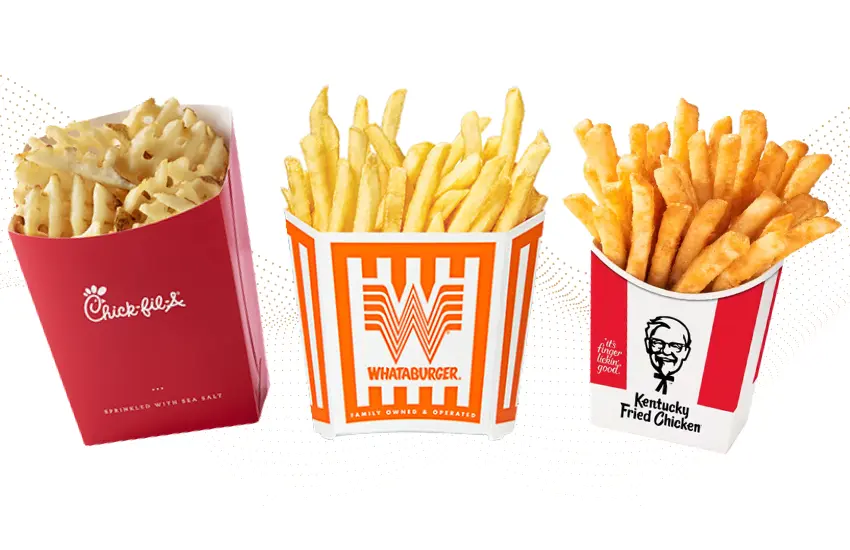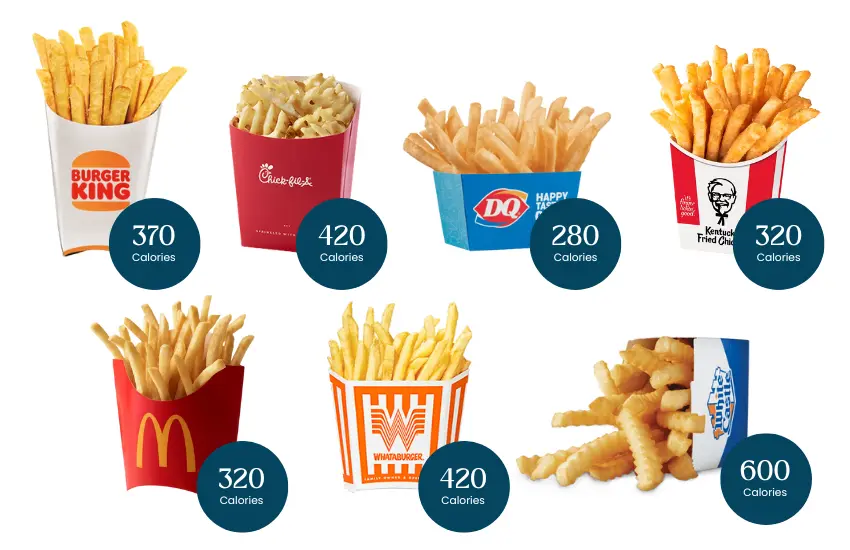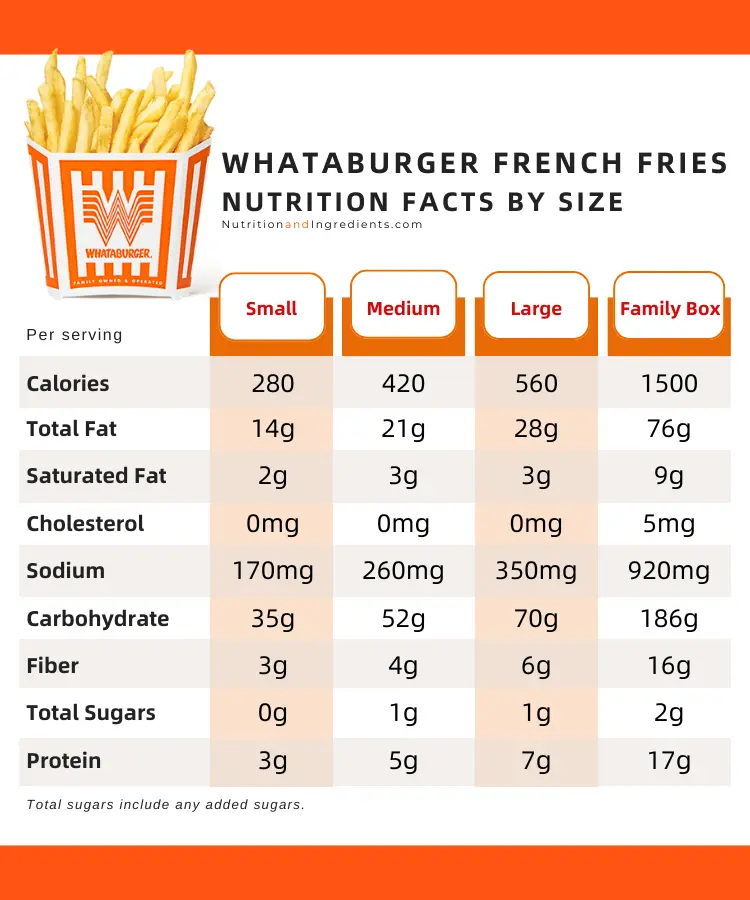7 Fast Food French Fries Reviewed: Which is Best?

This new food guide compares the nutritional values of french fries from seven of the nation’s leading fast food restaurants.
We may all have our favorite based on taste and texture, but have you ever wondered what’s actually in the food?
Take Chick-fil-A’s new recipe, for example. The famous chicken restaurant started using pea protein in their highly popular waffle fries. Some consumers love the extra crispiness, while other reviewers beg for a return to the prior recipe. Unfortunately, there are even some guests who have a food sensitivity to peas so the fries are now off limits.
Read this food comparison report for an in-depth overview of the nutritional values in each order of fries followed by a detailed review of the ingredients in fast food french fries.
This report provides an in-depth review of french fries from the following fast food restaurants:

Fast Food French Fries Nutritional Review
This first section of the food guide compares and contrasts the amount of total fats, carbohydrates, sodium, and other nutrients in each serving of fast food fries.
Calories
Calories are generated from the macronutrients fat, carbs, and protein. Let’s start with a summary of total calories. The next section dives into specific macronutrients.
Calories in French Fries
|
Per Medium* Order |
Total Calories |
|---|---|
|
Burger King |
370 |
|
Chick-fil-A |
420 |
|
Dairy Queen |
280 |
|
KFC |
320 |
|
McDonald’s |
320 |
|
Whataburger |
420 |
|
White Castle |
600 |
Dairy Queen order size = Regular; KFC order size = Individual.
An order of french fries from Dairy Queen has the fewest calories. White Castle comes out on top with a staggering 600 total calories per order.

Comparison of Macronutrients
Now let’s dig a little deeper with a comparison of macronutrients: fat, carbs, and protein. Use this report to compare a single order from one restaurant to the next.
Nutritional information in this guide is based on a Medium Size, or equivalent.
Unless otherwise stated, nutritional info is based on a size medium, with the exception of Dairy Queen, which uses a label of “Regular” and KFC, which is based on the “Individual” order.
Macronutrients in an Order of Fries
|
Per Medium Order* |
Total Fat |
Carbs |
Protein |
|---|---|---|---|
|
Burger King |
16g |
54g |
5g |
|
Chick-fil-A |
24g |
45g |
5g |
|
Dairy Queen |
13g |
36g |
5g |
|
KFC |
15g |
41g |
5g |
|
McDonald’s |
15g |
43g |
5g |
|
Whataburger |
21g |
52g |
5g |
|
White Castle |
39g |
57g |
6g |
Dairy Queen order size = Regular; KFC order size = Individual.
Six of the seven french fry options contain five grams of protein per serving. White Castle’s fries have a slightly higher amount of protein at 6 grams.
There is greater variation in the amount of total fat and carbs.
Nutrients with a 20% DV or greater is considered high.
The U.S. FDA suggests reviewing nutrition facts labels and using the percentage daily value (%DV) as a measure to help determine if a nutrient in one serving is low, medium, or high.
A daily value of 20% or higher per serving is high. If it’s 5% or less, it’s considered low.
Dietary Fats
At the lowest end of the range is Dairy Queen with 13 grams of total fat. That’s about one third the amount of total fat in an order of White Castle’s classic crinkle cut fries, which has the highest amount at 39g total fat.
|
Least Amount of Fat |
Most Amount of Fat |
|---|---|
|
Dairy Queen Fries |
White Castle Fries |
|
13 grams |
39 grams |
Fries Contain a High Amount of Total Fat
Dairy Queen’s fries have a daily value of 17%. That’s not low, but it also doesn’t cross the 20% warning threshold. However, four of the restaurants under review do exceed a 20% daily value.
Saturated Fat
In addition to quantity of total fat, consumers should carefully consider saturated fat.
Here is a summary of the total fat, saturated fat, and percentage daily value (based on a 2,000 calorie diet) for each menu option.
%DV of Total Fat and Saturated Fat
|
Size Medium* |
Total Fat (%DV) |
Saturated Fat (%DV) |
|---|---|---|
|
Burger King |
16g (20%) |
2g (10%) |
|
Chick-fil-A |
24g (31%) |
4g (20%) |
|
Dairy Queen |
13g (17%) |
2g (10%) |
|
KFC |
15g (19%) |
2g (10%) |
|
McDonald’s |
15g (19%) |
2g (10%) |
|
Whataburger |
21g (27%) |
3g (15%) |
|
White Castle |
39g (50%) |
7g (35%) |
* DQ = Regular, KFC = Individual. %DV is based on a 2,000 calorie daily diet
2 Restaurants Serve Fries with High Saturated Fat
The saturated fat content in french fries from Chick-fil-A and White Castle equates to a 20% or more daily value.

Sodium
Another potential area of concern in fast food menu items, especially fried foods, is the sodium content. French fries are no exception. The amount of sodium per serving is high.
Amount of Sodium in French Fries
|
Based on Medium* |
Sodium |
% Daily Value |
|---|---|---|
|
Burger King |
270mg |
12% |
|
Chick-fil-A |
240mg |
10% |
|
Dairy Queen |
590mg |
26% |
|
KFC |
1100mg |
48% |
|
McDonald’s |
260mg |
11% |
|
Whataburger |
260mg |
11% |
|
White Castle |
85mg |
4% |
Dairy Queen = Regular; KFC = Individual. %DV based on 2,000 calories
If sodium is a concern, consider ordering from White Castle, which has the least amount of sodium amongst all french fries we reviewed.
Alternatively, order one of the smaller sizes available on the menu. Burger King, for example, offers a much smaller portion marketed as the “Value” size. Enjoy the salty, crispy side dish with only 170 milligrams of sodium per serving.
Two restaurants have a high amount of sodium:
Nutrition Facts
Serving Size 1 Order
|
Burger King |
Chick-fil-A |
Dairy Queen |
KFC |
McDonald’s |
Whataburger |
White Castle | |
|
Calories |
370 |
420 |
280 |
320 |
320 |
420 |
600 |
|
Total Fat (g) |
16 |
24 |
13 |
15 |
15 |
21 |
21 |
|
Saturated Fat (g) |
2 |
4 |
2 |
2 |
2 |
3 |
4 |
|
Sodium (mg) |
270 |
240 |
590 |
1100 |
260 |
260 |
85 |
|
Carbs (g) |
54 |
45 |
36 |
41 |
43 |
52 |
57 |
|
Protein (g) |
5 |
5 |
5 |
5 |
5 |
5 |
6 |
French Fries Ingredients by Restaurant
Common Ingredients
Fast food recipes for the same menu item often contain some of the same ingredients. In the case of french fries, all of the restaurants use potatoes, salt, and vegetable oils.
Here is a list of ingredients and additives used by more than one restaurant.
Ingredients Used by Multiple Restaurants
|
Dextrose |
Rice Flour |
|
Disodium Dihydrogen Pyrophosphate |
Salt |
|
Leavening Agents |
Vegetable Oils |
|
Potatoes |
Xanthan Gum |
What are These Ingredients?
Most consumes have never heard of some of the ingredients used in fast food french fries. They’re tongue-twisters and rarely, if ever, used in household kitchens.
To learn more about what’s in this popular side dish, let’s start with brief definitions of select ingredients used in fast food french fries.

Chick-fil-A Waffle Fries Ingredients
Here is the complete list of ingredients in Chick-fil-A Waffle Fries.
Ingredients |
|---|
|
Potatoes, High Oleic Canola Oil, Vegetable Oils (canola, palm, and/or soybean), Modified Food Starch (corn, potato, and/or tapioca), Leavening, Rice Flour, Salt, Dextrose, Xanthan Gum, Dextrin, Pea Starch, Disodium Dihydrogen Pyrophosphate |
Dairy Queen Fries Ingredients
Here are the ingredients in Dairy Queen’s fries.
Ingredients |
|---|
|
Potatoes, Vegetable Oil (Canola, Sunflower, Cottonseed, Palm, Corn, Soybean), Modified Food Starch (Potato, Corn, Tapioca), Rice Flour, Dextrin, Salt, Leavening (Disodium Dihydrogen Pyrophosphate, Sodium Bicarbonate), Dextrose, and Xanthan Gum. Cooked in Soybean Oil. |
KFC Fries Ingredients
Here are the ingredients used to make KFC Secret Recipe Fries.
Ingredients |
|---|
|
Sea Salt, Monosodium Glutamate, Maltodextrin, Salt, Dextrose, Vegetable Powders (onion, carrot, tomato), Tricalcium Phosphate, Hydrolyzed Soy Protein, Spices, Soybean Oil, Natural Flavors, Potassium Chloride, Paprika Extract (color), Turmeric Extract (color), Potatoes, Vegetable Oil (soybean, canola, cottonseed, and/or sunflower), Bleached Wheat Flour, Rice Flour, Durum Wheat Semolina, Dextrin, Degermed Yellow Corn Meal, Cornstarch, Leavening (sodium acid pyrophosphate, sodium bicarbonate), Xanthan Gum, Annatto Extract (color), and Disodium Dihydrogen Pyrophosphate. |
Rice flour, Dextrose, and Modified Food Starch are used by multiple restaurants.
McDonald’s French Fries Ingredients
Here is the list of ingredients used in McDonald’s fries.
Ingredients |
|---|
|
Potatoes, Vegetable Oil (canola oil, corn oil, soybean oil, hydrogenated soybean oil, and natural beef flavor, which contains wheat and milk derivatives), Dextrose, Sodium Acid Pyrophosphate, Salt |
Whataburger Fries Ingredients
In addition to the shortening used for cooking, Whataburger fries contain five ingredients:
Ingredients |
|---|
|
Potatoes, Soybean Oil, Dextrose, Disodium Dihydrogen Pyrophosphate. Deep-fried in ZTF Whataburger liquid shortening and seasoned with Whataburger fry salt (a salt flour consisting of natural crystalline) |
White Castle French Fries Ingredients
Ingredients for White Castle fries vary by region. An aggregated list for all restaurants is included below. Ask the manager at your local restaurant for which specific ingredients are used at that location.
Ingredients* |
|---|
|
Potatoes, Vegetable Oil (Canola, Corn, Cottonseed, Palm, Soybean, Sunflower), Disodium Dihydrogen Pyrophosphate, Dextrin, Dextrose, Potato Starch – Modified, Leavening (Sodium Acid Pyrophosphate, Sodium Bicarbonate), Pea Fiber, Pea Protein, Rice Flour, Salt, Sodium Acid Pyrophosphate, TBHQ, Citric Acid (preservatives), Xanthan Gum, and Dimethylpolysiloxane (anti-foaming agent). *Not listed in descending order of dominance |

Nutrition facts, prices, and ingredients are based on available information as of the date of publication. Restaurants and food manufacturers may change recipes or formulations without notice. Check package labels and ask the product manufacturer or restaurant for the most up-to-date information. Unless otherwise stated, %DV is based on a 2,000 calorie diet. All reports and reviews published on this site are for informational purposes only. NutritionandIngredients.com does not provide healthcare advice or dietary recommendations. Always consult your licensed physician for any healthcare or dietary advice.

